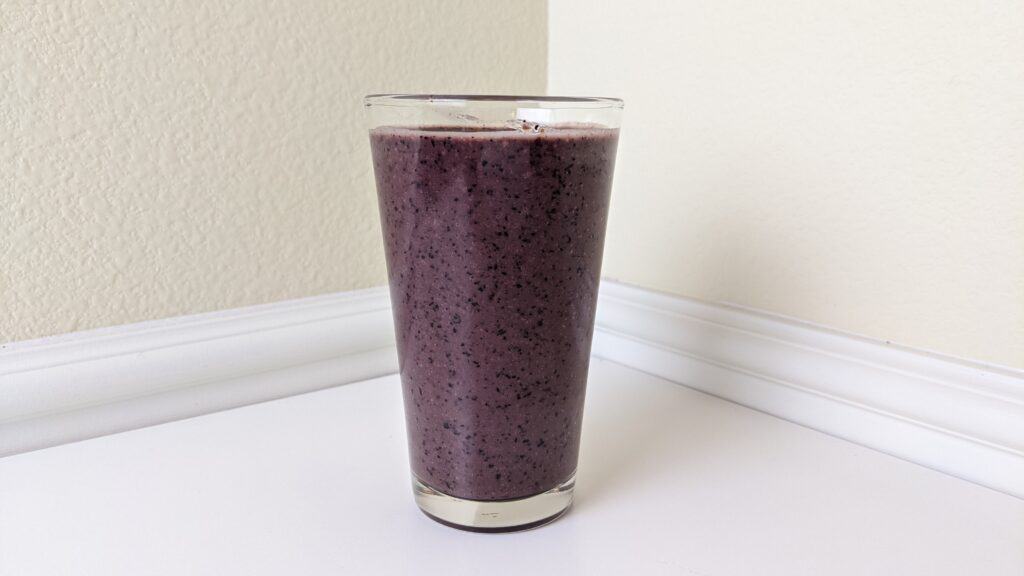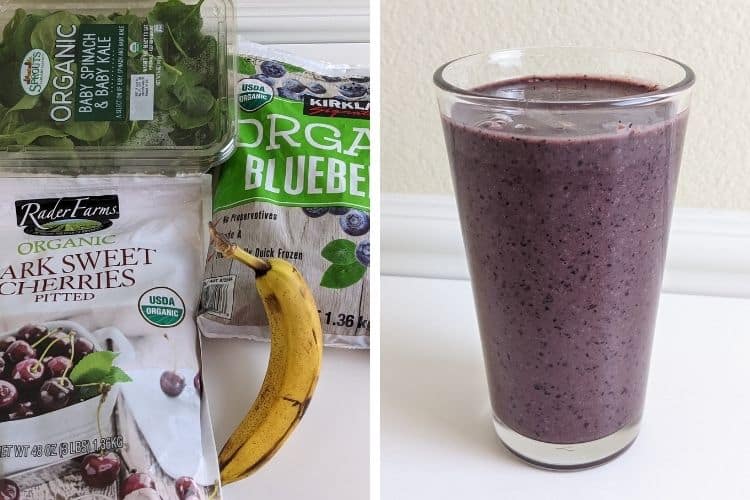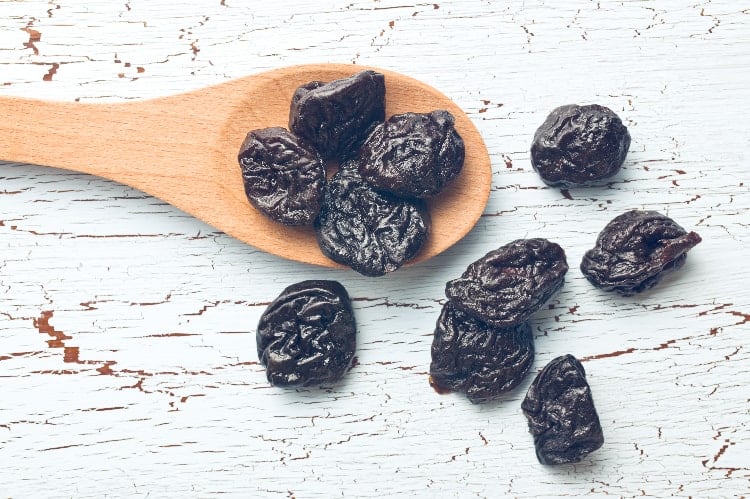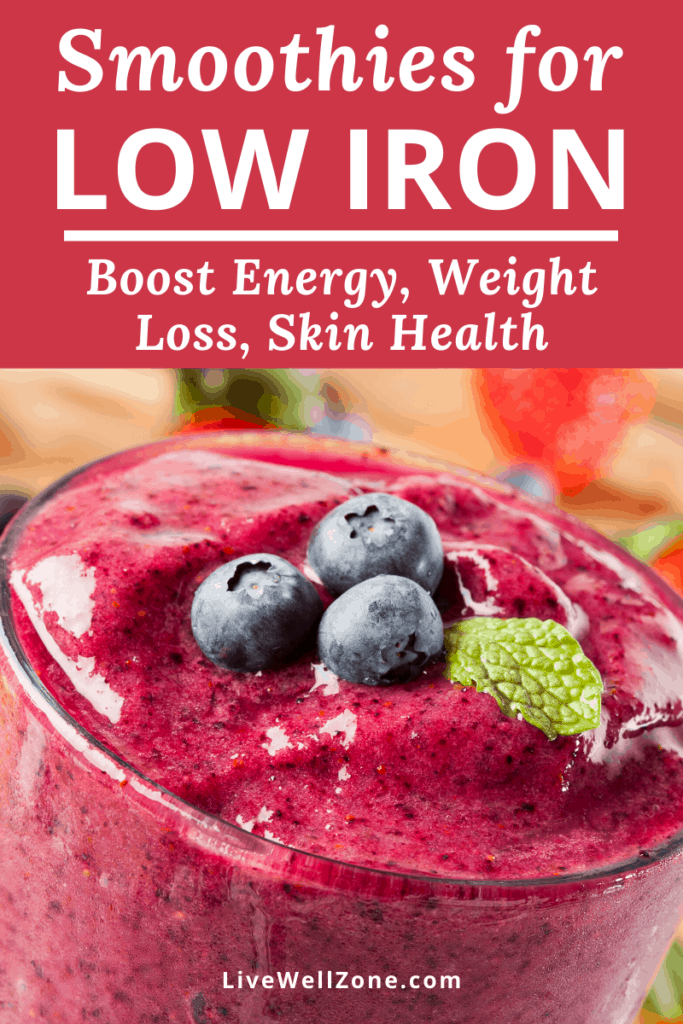
Boosting your iron levels naturally can feel like a slow and frustrating journey. However, drinking smoothies for low iron can help to alleviate some of that frustration. Not only are smoothies quick to make, but once you understand what the body needs for proper iron absorption, you can combine everything in one healthy drink.
So, to help you get started, we’re going to look at:
- a couple of iron-boosting smoothie recipes that you can add to your diet.
- the best animal and plant sources of iron.
- tips for boosting iron absorption.
- how iron deficiency affects weight and other aspects of our health.
GREEN SMOOTHIE RECIPES FOR LOW IRON

Now it’s time to make our iron-boosting green smoothies (they’re “green” because of the spinach content, even though the color doesn’t always reflect this).
Please note that even though the ingredients in these recipes contain iron (in varying amounts), these smoothies alone won’t give you all of your daily requirements for iron. They should be used as part of a balanced, iron-boosting diet.
Also, keep in mind that for women, daily iron requirements are:
- 18mg for non-pregnant women aged 19-50
- 27mg for pregnant women.
Now, on to the recipes 🙂
NOTE: I like to thaw out my frozen fruit a little by leaving it out for about 30 minutes. Makes it easier to blend and it’s not so bone-chilling cold 🙂
Blueberry Cherry and Hemp Seed Smoothie (1 16-oz serving)
1 fresh medium-sized bananas (0.31mg iron)
1 cup baby spinach or 1 cup mixed baby kale/baby spinach (about 0.68mg iron)
1 cup frozen blueberries (0.4mg iron)
½ cup frozen sweet cherries (0.3mg iron)
1 tbsp hemp seeds – blend it into the smoothie or use as a topping (0.79mg iron)
1/2 cup water (adjust amount depending on how thick you want the smoothie to be)
IRON CONTENT: 2.48mg (13.8% of recommended daily intake for a non-pregnant woman)
Avocado Blueberry and Hemp Seed Smoothie (1 16-oz serving)
1 fresh medium-sized bananas (0.31mg iron)
1 cup baby spinach or 1 cup mixed baby kale/baby spinach (about 0.68mg iron)
1.5 cup frozen blueberries (0.6mg iron)
½ fresh, ripe avocado (0.4 mg iron)
1 tbsp hemp seeds – blend it into the smoothie or use as a topping (0.79mg iron)
1/2 -3/4 cup water (depending on how thick you’d like this to be)
TOTAL IRON CONTENT: 2.78mg (15.4% of recommended daily intake for a non-pregnant woman)
BEST FOODS TO EAT FOR IRON DEFICIENCY

If you’ve been wondering, which fruits are high in iron or which nut is highest in iron, then this is for you!
There are two types of iron in food: heme (from animals) and non-heme (from plants).
And within both categories, there are various foods that you can enjoy!
Now, since we’ll be making smoothie recipes for low iron, we will be using plant-based ingredients.
However, below is a list of both heme and non-heme sources of iron (source).
- Fresh fruits like avocados, prunes, mulberry and olives
- Dried fruit (particularly apricots, prunes and raisins)
- Dark leafy greens (kale, spinach, collard, chard, beet greens and so on).
- All legumes (red beans, black beans, lima beans, chickpeas, lentils, black eyed peas and so on).
- Nuts and seeds (almonds, pumpkin seeds, pistachios, cashews, sunflower seeds, etc.)
- Sea vegetables like spirulina and kelp.
- Maca root
- Tomato paste
- Grains like quinoa, oats, spelt and amaranth
- Coconut milk
- Herbs like thyme, parsley and spearmint
- Blackstrap molasses
- White mushrooms and oyster mushrooms
- Potato (with the skin)
- Cacao powder
- Fish (best are sardines, tuna, salmon, haddock, halibut and perch).
- All meats (beef, lamb and venison have the most iron. Poultry has less. Organ meats, like liver, also have iron).
WHAT PREVENTS ABSORPTION OF IRON AND WHAT TO DO ABOUT IT
When it comes to things that inhibit iron absorption, there’s confusing and contradictory information from medical and research experts. For example, it’s generally said that tannins (in tea), oxalates (in leafy greens, for example) and phytates (found in legumes) inhibit or reduce iron absorption (particularly non-heme iron).
| Things That Can Reduce Iron Absorption |
|---|
| Tannins in teas (black, green and some herbal teas) |
| Herbal teas that are high in polyphenols (chamomile, peppermint, vervain and others) |
| Phytates in legumes, tea and coffee |
| Oxalates in leafy greens, tea and coffee |
| Caffeine and high fiber foods |
| Calcium |
But on the flip side we also know that spinach and legumes are natural sources of iron.
So, this begs the question: what can you actually eat? Are leafy greens or legumes a reliable source of iron? Should you avoid calcium-rich foods?
Well, after doing more investigating on all this, here’s my take on all this:
- Consume heme iron with non-heme iron: heme iron is easier to absorb and facilitates the absorption of non-heme iron when they’re combined in the same meal.
- Eat plant iron with vitamin C: vitamin C is known to enhance the absorption of plant iron. In fact, according to this study when there are “sufficient amounts” of vitamin C in a meal, it counteracts the inhibitory effect of things like tannins. Unfortunately, the study doesn’t provide an actual value for what “sufficient amounts” are. So, just use your best judgment and make sure that you have additional sources of vitamin C in your meal. And by the way, all of the smoothie recipes above include additional sources of vitamin C (blueberries, cherries, avocado).
- Eat non-heme iron with vitamin A: vitamin A also increases iron absorption. So, include foods like sweet potatoes, carrots or papaya in your meals.
- Drink tea and coffee between meals: this minimizes the impact of those potentially inhibitory compounds that are in both drinks.
- It now seems that calcium’s inhibitory effect on iron absorption is only short-term. Studies that look at long-term calcium supplementation show that it doesn’t have a negative effect on iron (source).
- The health of the digestive system is the biggest factor in whether or not we absorb any nutrients. So, pay attention to your digestive health to make sure you are actually getting what you need.
- Studies sometimes (not always) test compounds in isolation (i.e. not the whole food, but just one nutrient from the food). So, the results can end up being different from what we’d see when consuming whole food. This can account for some of the contradictory information surrounding nutrients.
- No food has been fully and totally researched. 10 or 50 years from now, we might once again get new information about all this. I know that’s not great news but that’s the nature of medical research.
- At the end of the day, if you prioritize eating a variety of whole, unprocessed foods your body will always be better off.
WHAT IS A LOW IRON LEVEL FOR A WOMAN?
For women with iron deficiency anemia iron levels below 10 micromoles per liter (mmol/L) is considered low.
However, keep in mind that measuring the amount of iron in your blood isn’t enough to accurately diagnose anemia.
This is because your blood levels can be normal while the total amount in your entire body (tissues and muscles, for example) is still low.
So, when testing for anemia doctors typically check other things such as (3, 4, 5) :
- Ferritin: this is a protein that stores iron. Low ferritin usually indicates iron deficiency.
- Hematocrit: this measures the percentage of your blood that is made up of red blood cells. The normal range for adult women is 35.5% to 44.9%.
- Hemoglobin: this is the protein in your red blood cells that transports oxygen. The normal range for adult women is 11.6 to 15. g/dL. A lower count usually signals insufficient iron.
- Red blood cell color and size: red blood cells that are smaller and pale in color generally occur with iron-deficiency anemia.
WHAT HAPPENS TO THE BODY WHEN YOU ARE ANEMIC
When the body is anemic that means there are not enough red blood cells to transport oxygen throughout the body.
As a result of not getting enough oxygen, two main things occur:
- Various processes in the body don’t work correctly.
- You feel extremely tired and fatigued.
Because anemia affects various bodily functions, the symptoms can vary widely from one person to another.
However, some of the most common signs of anemia include (1, 2):
- fatigue.
- difficulty concentrating.
- shortness of breath.
- heart palpitations.
- feeling cranky or irritable.
- restless leg syndrome.
- cold hands and feet
- frequent infections.
- pale skin color (gums, inside of lips, inside of lower eyelids and nails).
- dry hair, skin and nails.
- cravings for ice or more starchy foods.
- headaches (sometimes accompanied by dizziness).
- changes in the tongue: swollen, dry, pale or a texture that is too smooth.
- changes in the mouth: dryness, sores, cracks.

HOW IRON DEFICIENCY CONTRIBUTES TO WEIGHT GAIN
According to some studies, there’s a link between low iron and weight gain.
And that link is the thyroid.
You see, the thyroid is responsible for regulating our metabolism.
And that means the thyroid has a direct impact on our ability to lose or gain weight.
Now, what’s interesting is that iron is necessary for the production of thyroid stimulating hormone (TSH).
So, this means that low iron levels contribute to both anemia and thyroid dysfunction (more commonly hypothyroidism, but sometimes hyperthyroidism).
In fact, the numbers indicate that 43% of people with hypothyroid symptoms also have anemia (compared to 29% in the general population).
Furthermore, a small study done with women who have hypothyroidism, showed that even after treatment with levothyroxine (a thyroid drug) 30 to 50% of them still had symptoms that were likely due to anemia.
While more research is needed, the main thing to note here is that iron is important for thyroid hormones.
Therefore, low iron affects the thyroid, which affects your metabolism and ultimately, your weight.
RELATED QUESTIONS
How can I raise my iron levels quickly?
Consume a variety of iron-rich foods and if you’re vegetarian or vegan, make sure to include vitamin C-rich foods in your meals (to boost absorption of plant iron).
Can stress lower iron levels?
Yes, some animal studies indicate that elevated, chronic stress lowers blood levels of iron and also inhibits iron absorption (8, 9)
CONCLUSION
As you can see there are a variety of foods that you can eat for optimal iron levels.
And feel free to play around with the smoothie recipe I’ve shared with you.
You can use almond milk instead of water (to get more iron) or replace hemp seeds with another seed like pumpkin.
Rotating these ingredients will keep you from getting bored with the same recipe.
As always if you have any questions or feedback, just drop a comment below 🙂
Related Posts:
Eating Dates For Iron Deficiency: Benefits, How Many and Best Types
Beet Smoothie for Low Iron: Benefits, Which Parts To Use (Root vs. Leaves) and Recipe
Best Ingredients For Weight Loss Smoothies


